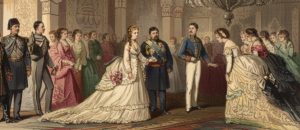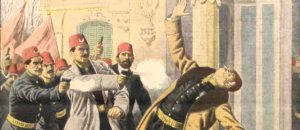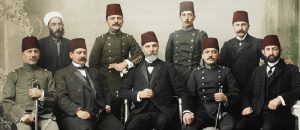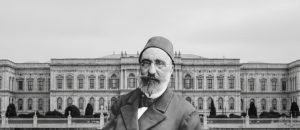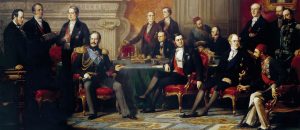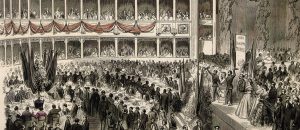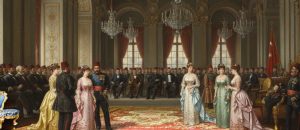The visits made by the allied emperors of Germany and Austria-Hungary to Dolmabahçe Palace during the years of World War I were the last diplomatic maneuvers and the final glimmers in the twilight of an empire. These visits, entirely different from the glorious and optimistic atmosphere of the 19th century, (Link: where guests like Prince Edward were hosted -> /iki-imparatorlugun-veliahtlari-prens-edwardin-dolmabahce-ziyareti-ve-osmanli-ingiliz-ittifaki), were overshadowed by the pessimism, scarcity, and sadness of the approaching end brought by the war. The wartime visits of German Emperor Wilhelm II and Austrian Emperor Karl I were a final, poignant display of solidarity by three collapsing empires desperately clinging to each other to stay afloat. (Link: Politics and diplomacy during the Dolmabahçe period -> /learn/politics-diplomasi-and-the-state)
Shifting Alliances, Changing Guests
Throughout the 19th century, the main axis of Ottoman diplomacy was the alliance formed with Britain and France against Russia. Dolmabahçe Palace had witnessed the brightest days of this alliance. However, the balance shifted at the beginning of the 20th century. The rapprochement between Britain and France and Russia, combined with their increasingly open ambitions over Ottoman territories, pushed Istanbul to search for a new ally: Germany. (Link: The Committee of Union and Progress administration led by Enver Pasha -> /bab-i-ali-baskini-uc-pasa-enver-talat-cemal-iktidari-saraydan-ve-hukumetten-nasil-sokup-aldi), saw the empire’s salvation as leaning upon German military and industrial power. This new alliance determined who the empire’s final guests would be.
Visits in the Shadow of War: Wilhelm II and Karl I
During the most difficult days of the war, two important visits took place with the aim of boosting the allies’ morale and demonstrating the strength of the alliance to the world.
The Visit of German Emperor Wilhelm II (1917)
German Emperor Wilhelm II, as the Ottoman Empire’s most important ally, visited Istanbul for the third and final time in 1917. However, unlike his previous visits, this visit lacked great enthusiasm and splendor. Due to the war, the city was suffering from food shortages; the public was exhausted and hopeless. The ceremonies and feasts held in his honor at Dolmabahçe Palace were not enough to dispel the pessimistic atmosphere outside. While Wilhelm II presented Sultan Mehmed V Reşad with a German field marshal’s baton, both sovereigns were, in fact, aware that the war was not going well and the end was approaching. Contrary to the strength it sought to project, this visit resembled an admission of weakness and despair. In the palace corridors, the shadow of a losing war, not a winning victory, lingered.
The Visit of Austrian Emperor Karl I (1918)
The visit of Austro-Hungarian Emperor Karl I and Empress Zita, which took place in 1918 during the final year of the war, had an even sadder atmosphere. The young emperor, who had recently ascended the throne, had come to reinforce the last bond between the two allied empires that were about to collapse. They were hosted at Dolmabahçe Palace by the new Sultan Mehmed VI Vahideddin. However, during this visit, news of continuous defeats was arriving from the fronts. Feasts were held, and speeches of friendship were given, yet everyone knew this was the final salutation between the captains of two sinking ships. This visit was the last visit by a foreign head of state hosted by Dolmabahçe Palace during the imperial period. A few months later, both empires would be erased from the stage of history.
A Dim Atmosphere: The Empire’s Last Breath
The fundamental difference that separated these wartime visits from the previous ones was the dimness and artificiality of the atmosphere.
- Economic Hardships: The place of the abundant and diverse feasts of the past had been taken by menus prepared with the limited means brought by the war economy.
- Public Participation: The enthusiasm in the city had given way to war fatigue and indifference. The welcoming ceremonies felt more like an official duty than spontaneous public participation.
- Political Reality: Everyone, especially the ruling elite, knew that the alliance was losing the war. Therefore, all these ceremonies and displays of friendship seemed like a desperate effort to cover up a bitter truth.
Dolmabahçe Palace, along with these last guests, was the stage for an empire’s final diplomatic bows.
Conclusion
In conclusion, the visits made by the allied emperors to Dolmabahçe Palace during World War I are among the most poignant scenes of an era’s close. These visits were desperate displays of solidarity, made in the shadow of war and with the sorrow of the approaching collapse. While Dolmabahçe fulfilled its duty as an international stage for the last time, it was actually witnessing its own end and the destruction of the imperial order it represented. When these last guests in the twilight departed, the palace lights dimmed, not to shine as they once had again.








